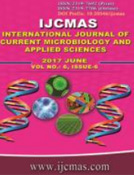


 National Academy of Agricultural Sciences (NAAS)
National Academy of Agricultural Sciences (NAAS)

|
PRINT ISSN : 2319-7692
Online ISSN : 2319-7706 Issues : 12 per year Publisher : Excellent Publishers Email : editorijcmas@gmail.com / submit@ijcmas.com Editor-in-chief: Dr.M.Prakash Index Copernicus ICV 2018: 95.39 NAAS RATING 2020: 5.38 |
Diabetic foot is one of the serious complications associated with diabetes and affects quality of life in respective patients in all ages and races. Diabetes mellitus is a disorder that shares the phenotype of hyperglycaemia. The prevalence of diabetes depends on many etiological factors such as age, sex, heredity, diet, socio-economic conditions and physical activity, environmental factors, life style choices etc. Diabetes is multi factorial disease in which various factors act in complex manner. A prospective study was carried out in department of microbiology at DR.B R Ambedkar Medical College & Hospital, Bangalore. Total of 120 samples with the clinical diagnosis of Diabetic Foot ulcer were collected and processed. Of the total 120 diabetic foot patients samples studied 80 were males and 40 were females, the male: female ratio being 2:1. The maximum number of patients having diabetic foot infections belonged to the age group of 56-65 years. Among the total pathogens isolated, 52.38% gram negative isolates and gram positive isolates i.e Staphylococcus aureus accounted for 47.62% and was the most common organism isolated, followed by Pseudomonas aeruginosa & Klebsiella spp, Escherichia coli.
 |
 |
 |
 |
 |